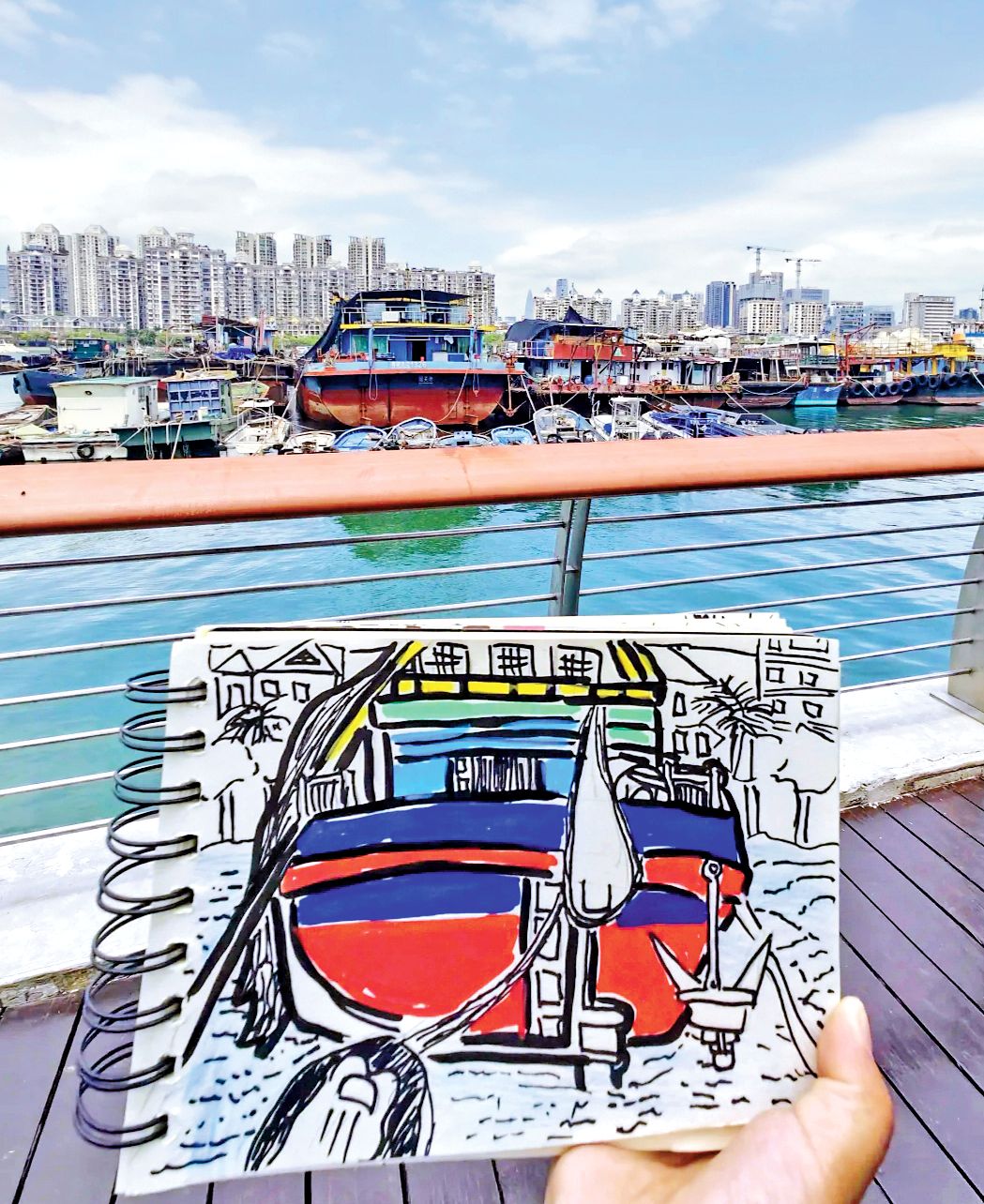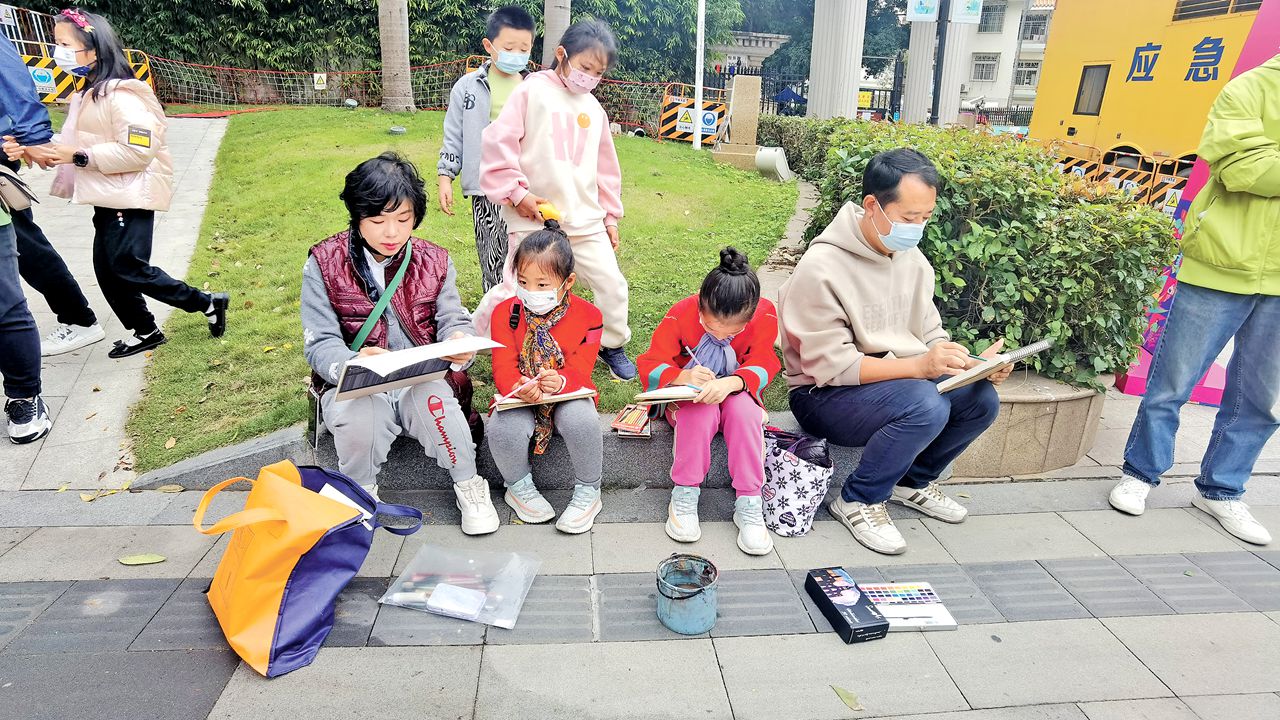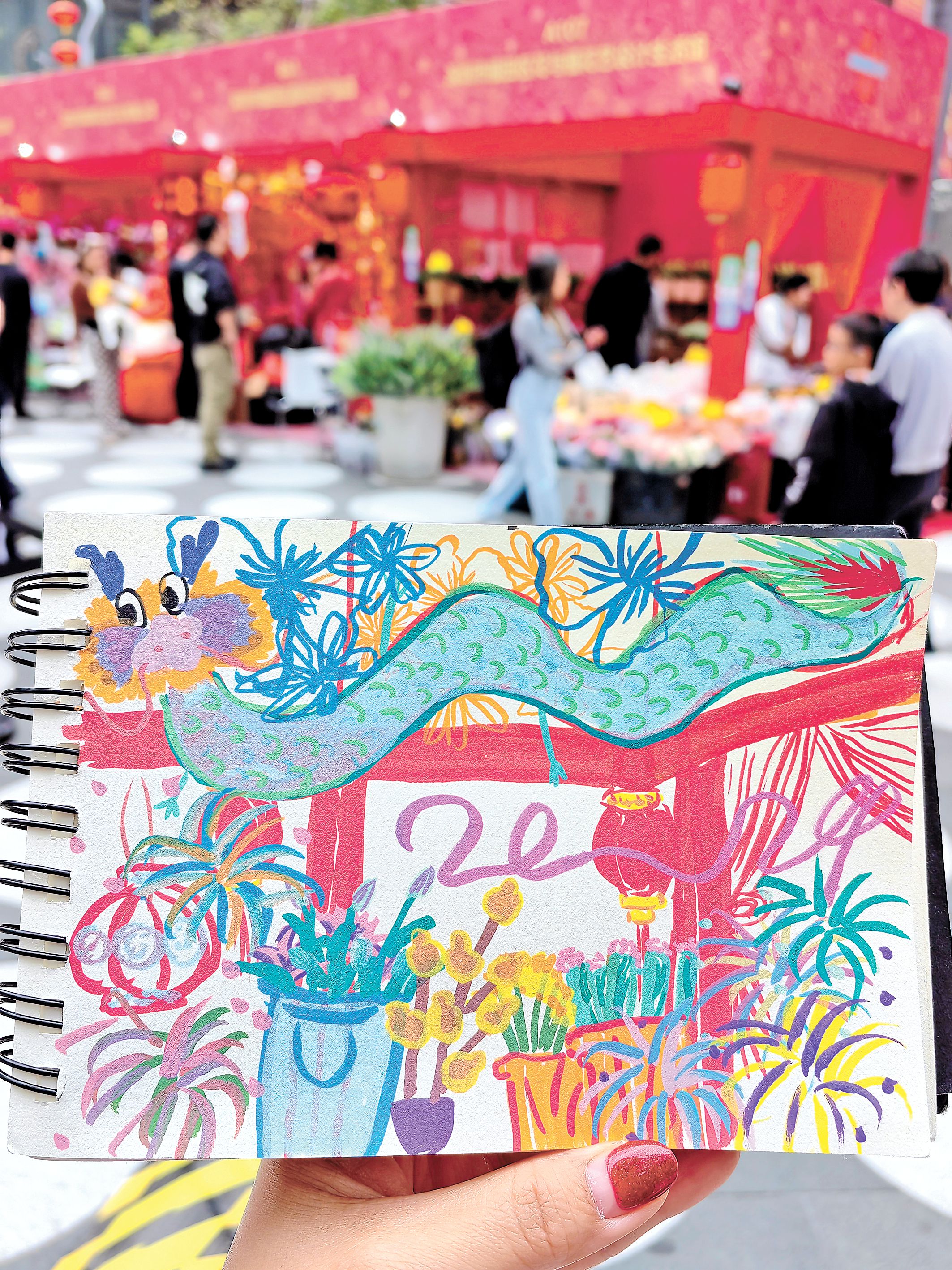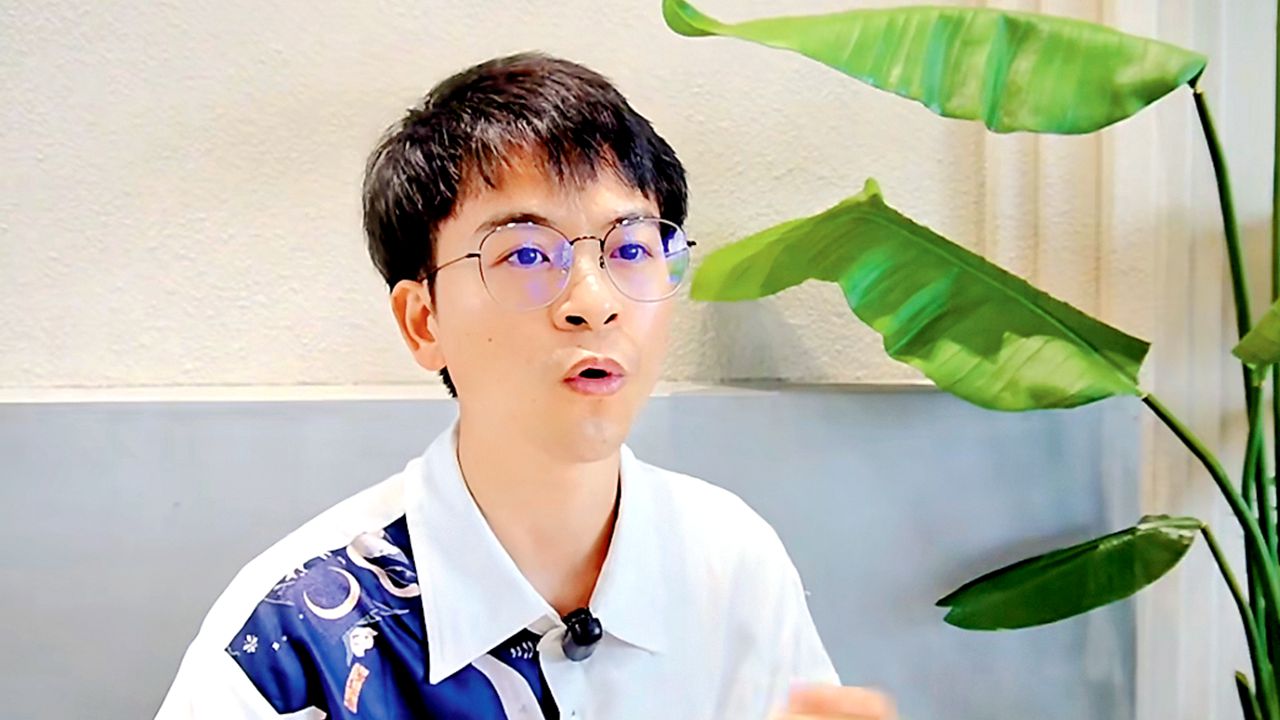Rediscovering SZ: How urban sketchers are capturing the city's hidden life
Writer: Wei Jie | Editor: Zhang Zhiqing | From: Original | Updated: 2025-06-25
In the fast-paced city of Shenzhen, countless stories unfold every day. Yet, we have become so accustomed to the urban hustle and bustle that we often forget to pause and observe the people around us and the buildings in our neighborhoods.

A sketch of a seaside view, by Li Yan's younger daughter, Liu Yani, is seen against the background of the depicted scene in Nanshan District's Shekou area. Photos courtesy of the interviewees
Every week, a dedicated group of people equipped with brushes and drawing gear heads into Shenzhen’s various corners. Through quick sketches, they capture everyday scenes that often go unnoticed, rediscovering neighborhoods and breathing new life into familiar surroundings.
Urban Sketchers initiative
Urban Sketchers (USK) is a global movement of artists who capture cities and daily life through on-site sketching. Founded in Seattle, the U.S., in 2007 by American journalist and designer Gabriel Campanario, the non-profit invites people from all backgrounds to document their world, one sketch at a time.
Guided by its motto, “See the World, One Sketch at a Time,” the movement emphasizes the practice of drawing directly from life. More than just creating art, it’s about building a community and showcasing the here-and-now of urban life around the world.

Participants holding their works pose for a group photo after a USK Shenzhen gathering in Shenzhen.
Inspired by this concept, Sketch Shenzhen, widely known as USK Shenzhen, was founded by local architect Wang Haikang on Aug. 20, 2017 as part of the Urban Sketchers international network. Aiming to cultivate an urban sketching culture and empower residents to rediscover the hidden beauty of their city, USK Shenzhen organizes weekly SketchWalk gatherings.
To date, USK Shenzhen has organized more than 400 drawing sessions through countless parts of the city. Their sketches observe and document Shenzhen’s many fleeting moments and the diverse faces of its people, creating a rich visual chronicle of Shenzhen’s ever-changing life.

Li Yan (L), a freelance architect, and her family sketch in a park in Shenzhen.
The organization initially consisted of mostly architects and urban planning designers, said Li Yan, an experienced freelance architect based in Nanshan District who has taken part in the weekly SketchWalk since 2000. “It sets no barriers for entry. Anyone interested can join the weekly gatherings,” she said.
Now, many art enthusiasts with professional backgrounds outside of art, such as finance professionals, show up at the weekly sessions. “Actually, some are pretty good. You can tell their ideas are quite different from those who have been professionally trained,” Li added.
Walking and drawing along the way
The SketchWalk gathering May 31 coincided with the Dragon Boat Festival and was held at the Xinzhou River Greenway in Futian District, where dragon boat races were being held.
Participants used their brushes to capture intense race scenes, cheering crowds along the river banks, and staff managing the event. The colors and lines in their sketches were simple, but these quick strokes infused the scenes with a unique personal perspective.
“Compared to photography, on-site drawing requires observing many details during the process, including the ever-changing light and shadows. It not only captures images but also conveys the sketcher’s emotions at that moment,” said Li.

A sketch of Shenzhen's flower fair by Li Yan's elder daughter, Liu Yaxuan.
Explaining the difference between on-site drawing and drawing from a photo or picture, she stated, “On-site drawing is so much more difficult, especially the first stroke. The translation process requires a lot of independent thinking, while drawing from a photo is more like the action of copying.”
Browsing USK Shenzhen’s WeChat and RedNote accounts reveals records of almost every SketchWalk gathering over the years. They have ventured into Xinyang Village, one of the oldest villages in Shenzhen, which dates back to the Southern Song Dynasty.
Along the coastal promenade in Shekou, they walked and sketched, reinterpreting the fishing boats docked at the pier against the backdrop of modern skyscrapers and the iconic white lighthouse that serves as both a picturesque landmark and a guiding beacon for fishing boats at dusk.
On one occasion, the group intended to sketch at Yabao Park in Longgang’s Bantian Subdistrict, but ended up discovering and exploring the 750-year-old Banruo Zen Temple. The sketchers’ footprints now span the entire city and record countless changes.
Sketching as a social tool
Affectionately called “Uncle” by fellow sketchers because of his beard, Wang Yure is currently the curator of USK Shenzhen. With a background in chemistry and experience working in environmental monitoring, Wang is very familiar with Shenzhen’s geography. That expertise led him to take on the important role of selecting locations for gatherings.
Wang has long been passionate about drawing. For him, finding a group that matches his low-key personality was particularly important. He said that USK Shenzhen offers him a different experience. “What attracts me most is the respect for individuality and personality. Here, no one criticizes or judges you.”
In Wang’s view, sketching on-site, compared to other painting styles, makes it easier to connect with the people around. He recalled that during a gathering in an old neighborhood in Longgang District, the owner of a nearby electronics repair shop took a keen interest in their drawing, made tea for the sketchers, and shared stories about the street.
Towards the end of each gathering, a sharing session allows participants to gather and talk about their creations. Sketches with unconventional perspectives are often favored over those viewed as traditionally well-drawn. According to Li, the group curator invites newcomers to introduce themselves, and the last person to do so chooses a drawing they like. Then, the person whose drawing is chosen shares the story behind it and selects another drawing they like. The process repeats.
Li has taken her two daughters to every single SketchWalk session and witnessed their tremendous growth over time. She said her elder daughter, Liu Yaxuan, gained confidence after attending the first gathering when her drawing received praise from the then-curator.
“After that, Xuanxuan hoped to get picked at every sketching session. She often got to share her work and became increasingly confident,” said Li, adding that the progress of her younger daughter, Liu Yani, now a third-grader, was even more remarkable.
Li recalled that the first SketchWalk her daughters attended was in an urban village. “Nini was so nervous that she could hardly start her first stroke on the ancestral hall. During that sharing session, she was afraid of being chosen, hid herself, and cried,” said the mother of two.
However, the more gatherings Nini attended, the more confident she became. “Now she can’t wait to share her drawings with other participants. She has become more sociable.”
Wang said, “Painting is also a means of socializing. When you’re drawing, people find you interesting, and it’s easier to connect with the outside world.”
Finding direction, maintaining passion

Fang Yongting takes an interview with reporters.
Fang Yongting caught the attention of Li every time the weekend SketchWalk was held at museums. “I noticed him because he always wears a Hanfu outfit for the event,” said Li. Fang is now an independent art content creator in Shenzhen and is best known as an enthusiastic sketcher of museum artifacts on the popular social media platform RedNote, where he has nearly 10,000 followers.
He said he picked up the hobby after joining USK Shenzhen. “A couple years ago, I happened to discover a group that focused on capturing scenes of Shenzhen, which I found very interesting, and decided to join,” he said. Since then, he often sketches various corners of Shenzhen. “Every time I go out to sketch, I feel happy and relaxed, and the usual ‘work stress’ seems to fade away.”
Over time, Fang has developed a signature style by using a specific kind of drawing paper to sketch cultural artifacts at museums. “I used to briefly browse exhibitions, take some photos, and leave. But now, by drawing cultural relics myself, it feels very different — it leaves a deep impression in my mind,” he said.
He shares his museum sketches on platforms like RedNote and WeChat, gaining many likes and receiving frequent inquiries about where to buy his artwork. “I felt so honored that my work is liked by others,” he said.
This admiration prompted him to have his sketches printed as postcards and sell them. Gradually, he was able to make ends meet this way and chose to become an independent art content creator.
Now in his late 30s, Fang graduated from the animation and art design department at Guangdong Second Normal University. He worked in graphic design, jewelry design, and illustration before finding his direction in life through museum sketching.
Gu Chuan, who majored in finance, vividly remembers his first Sketch Shenzhen gathering at the Yuanxun Old Residence in Luohu District. He recalled the organizer’s message — at the start, there’s no need to rush into drawing; walking around to learn about the environment and culture is even better.
Wu Siyao, a new media editor, finds the experience healing. Her work and life constantly revolve around the internet. But after joining USK Shenzhen, she found joy in real life. “Some places seemed boring before, but sketching makes them interesting.” In her view, “compared to those ‘perfect’ paintings, sketches have a vibrancy that surpasses perfection.”
Today, many USK Shenzhen members, like Li and her two daughters, have developed a habit of carrying sketching tools wherever they go. Ready to capture whatever they see, they maintain a passion for and sensitivity towards the life around them.